Cats play is defined as behavior that looks like amusement or entertainment for kittens and adult cats but is largely based on feline hunting techniques. Play is crucial for a cat’s development, especially when they are kittens, as it helps them hone their hunting skills, even if they are indoor cats and don’t actually need to hunt for food. Play also provides physical exercise and mental stimulation and is a good way for cats to bond with their owners or other cats.
Cats enjoy various ways of playing by themselves or with others, and you can play with your cat using a variety of toys. Vary the toys to keep the cat interested and stimulated in the games, and try not to overstimulate your kitty to prevent aggression.
Cats also play with each other. My two cats are brother and sister, and plenty of sibling rivalry is on display when they wrestle and play fight. But my furbabies also spend time grooming each other and snuggling up together after a game, so it’s all good!
Kittens and adult cats love to have a selection of toys to play with, including puzzle toys, scratching posts, laser pointers, and feather wands that mimic natural prey.
If you don’t already spend time playing with your cat, you should, as play is a fabulous way of bonding with your feline friend as well as exercising her physically and mentally.
Keep reading to learn how to play with your cat and make every day a feline fun day!
Why Is It Important For Cats To Play?
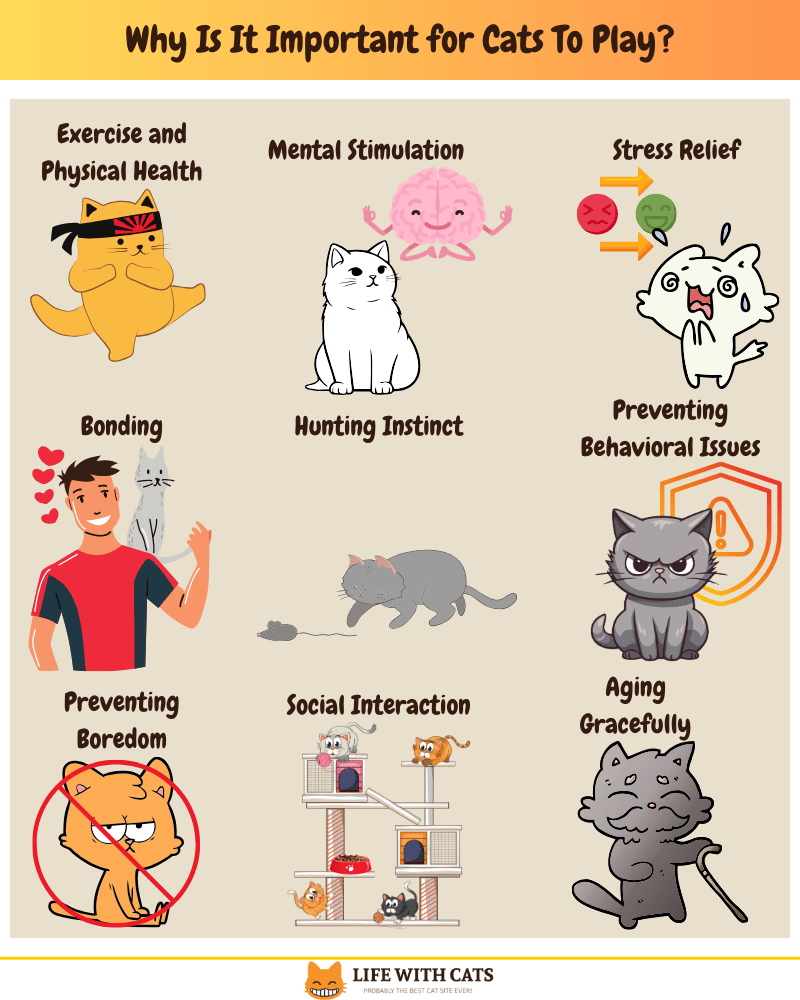
Cats play is important for their mental and physical health, preventing boredom, alleviating behavioral issues, and relieving stress.
Keep reading to learn more about why it’s so important that cats play!
Exercise And Physical Health
No one wants a tubby tabby, and cats need physical exercise to keep them fit and healthy! Obesity is common in cats and can lead to serious health problems, including diabetes, heart attacks, and high blood pressure. Incorporating play into your cat’s daily routine can ensure she gets plenty of physical exercise to burn off excess calories and has fun into the bargain.
Mental Stimulation
Indoor cats especially can easily become bored, and playtime is a great way of providing your cat with the mental stimulation she needs to keep her mind active and sharp. Boredom can cause behavioral problems, such as scratching furniture and aggression toward housemates, so be sure to set aside some time each day to play with your cat.
Stress Relief
Cats can become quite stressed, especially if they don’t have access to the outside and are indoors all day. Stress causes health problems and behavioral issues, but regular playtime can easily relieve your cat’s anxiety.
Bonding
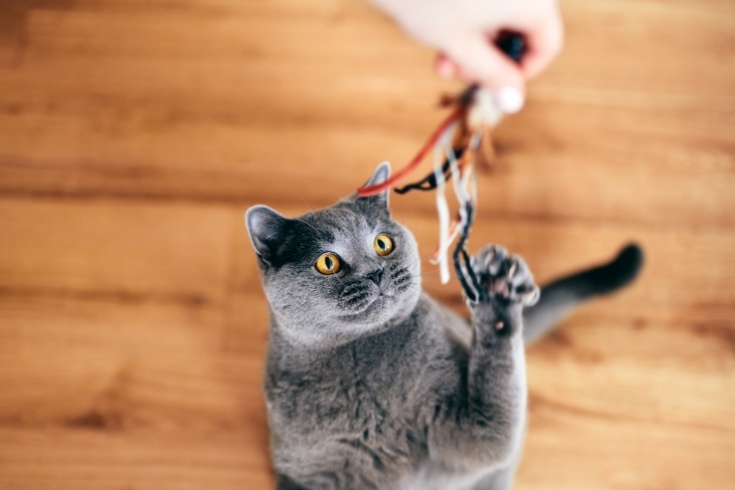
Interactive playtime is a fabulous way of bonding with your furry friend and learning more about her personality. Try incorporating play into your cat’s daily training routine to make teaching her new commands more fun and strengthen the bond between you.
Hunting Instinct
Domestic cats are descended from wild cats that hunted for food. Your cat has inherited the same hunting instincts and behaviors as her wild ancestors, as seen in her play.
For example, cats are notorious for catching mice and birds and love nothing more than stalking and pouncing on each other during play. Those actions are merely instinctual and are a great way of relieving stress and preventing boredom.
Preventing Behavioral Issues
As mentioned earlier, behavioral issues can result if your cat gets bored. A bored cat, especially a kitten, will get into mischief, potentially damaging your home furnishings or going exploring and getting stuck somewhere.
Keeping your cat busy by providing her with interactive toys and spending time playing with her is a great way of preventing those behavioral issues from becoming a problem.
Preventing Boredom
As mentioned above, even lazy cats can easily get bored, particularly if they don’t have access to your backyard hunting ground. Taking time out to play with your cat or buying her a new toy occasionally are easy ways to prevent your feline friend from getting bored.
Social Interaction

Although most cats appreciate some company, it’s easy for your pet to feel isolated if she is the only pet. Social interaction through play is extremely important for your cat’s mental well-being, so set aside a few minutes daily for games with your cat or a fun training session.
Aging Gracefully
Senior cats might not be as agile and lively as they once were, but even older kitties enjoy gentle games with their owners.
I once owned a senior cat of around 15 years of age who loved nothing more than to roll over onto his back and be pushed around the carpet on his back! He came back time and time again, obviously loving the fun, interactive game we played and making cute little chirping sounds the whole time.
How Do You Play With A Cat?
To play with your cat, you need to choose the right toys and learn what floats your feline friend’s boat when it comes to games.
For example, playing with a cat might involve recreating your kitty’s hunting expeditions by using a feather wand toy or a battery-operated mouse to get your pet active. Alternatively, your cat might prefer spending time hunting for treats in a snuffle mat or puzzle toy.
Here are our top tips on how to play with your cat!
Choose The Right Toys
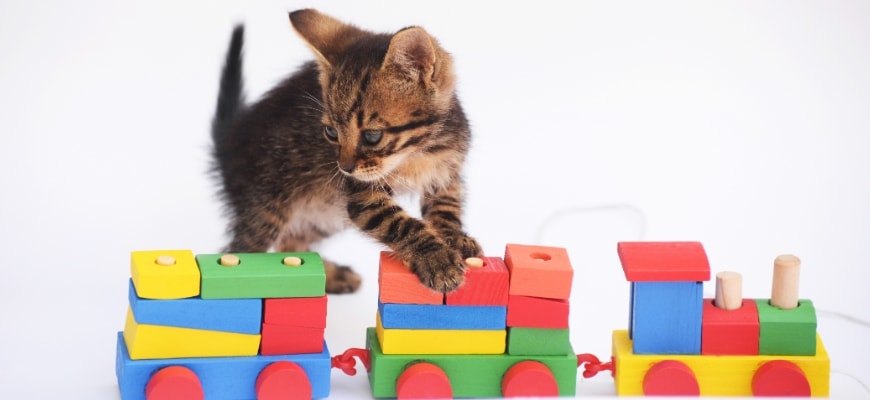
You must first work out what kind of games and toys your cat enjoys playing with and finds the most stimulating.
For example, some cats enjoy energetic hunting games, while others prefer something more gentle, such as figuring out how a puzzle game works to get a treat reward. It’s really a case of getting to know your cat through trial and error.
Create Movement And Imitate Prey
Most cats are stimulated by something that moves rapidly in the way that a prey animal would. Chasing after a feather wand toy, hunting down a mechanical catnip mouse, or dashing after a laser light beam are all excellent ways of creating movement and imitating prey.
Vary The Play Style
You would quickly become bored playing the same game every day, and your cat is no different! Cats are pretty intelligent creatures and need variation in the play style you offer them to keep them interested and stimulated mentally and physically. So, keep your cat entertained by using different toys and games, perhaps bursting with short training sessions.
Give Your Cat Control
Remember that playtime is for your cat’s benefit and not just for yours! Your cat will soon get fed up if you hog the toys or always dictate the game, so give your cat control by allowing her to catch the catnip mouse or grab the bunch of feathers from time to time.
Use Positive Reinforcement
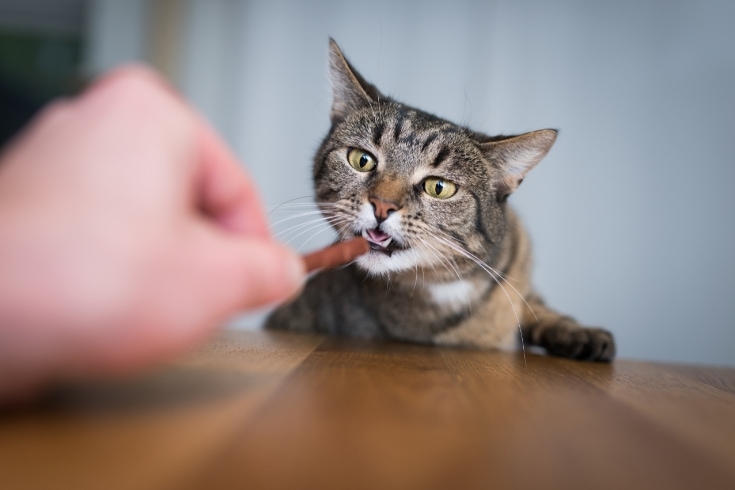
Use positive reinforcement methods throughout the games and training sessions by rewarding your cat whenever she does something correctly. You can use edible training treats as rewards or simply make a fuss of your cat if that’s what she prefers. Again, getting to know your pet’s preferences is down to you.
Be Patient And Respectful
When introducing a new toy or game to your cat, you must allow her time to understand it and get her head around what’s expected of her. That’s especially important if you have adopted a cat from a shelter or rescue center who might never have played games or even had an owner before.
So, be patient and respectful when playing with your cat, and always finish each session on a positive note.
Mind The Energy Level
Be careful not to exhaust your cat, particularly on hot days when she could be at risk of overheating or becoming dehydrated. Choose a time for play when your cat has just rested and has plenty of energy, and always be prepared to include plenty of breaks during play sessions. Keep playtimes and training sessions short and sweet, and never keep going when it’s clear your cat has had enough.
Avoid Overstimulation
Be careful not to overstimulate your cat, even though she appears to be having a great time. Sometimes, cats can become quite aggressive if you overdo things, especially when replicating hunting behaviors, and you don’t want to get scratched or bitten.
Interactive Puzzle Toys
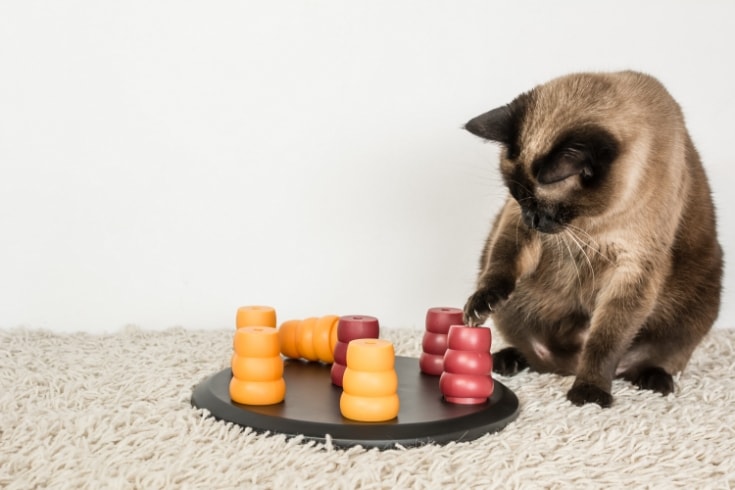
Interactive puzzle toys are a great way of providing your cat with mental and physical stimulation and can be extremely useful for keeping your pet occupied while you’re out at work during the day.
Incorporate Hide-And-Seek
Hide-and-seek is a game that many cats love to play with their owners and with each other. Recruit a friend or family member to keep your cat occupied while you go and hide somewhere nearby. Be sure to have a pocket full of treats ready to reward your cat when she finds you.
Use Scented Toys
You can buy lots of toys scented with catnip, including fluffy mice, balls, and kickers, which can tempt your cat to enjoy a romp.
Catnip can be a stimulant or a relaxant, depending on how your cat reacts to the herb, but most cats love it. Also, you can buy dried catnip and catnip-scented sprays to refresh scented toys when the aroma fades.
Rotate Toys
Keep your cat interested, prevent boredom, and spice up playtimes by rotating her toys. That helps keep playtimes fresh and saves you cash on new toys, too.
How Do Cats Play With Each Other?
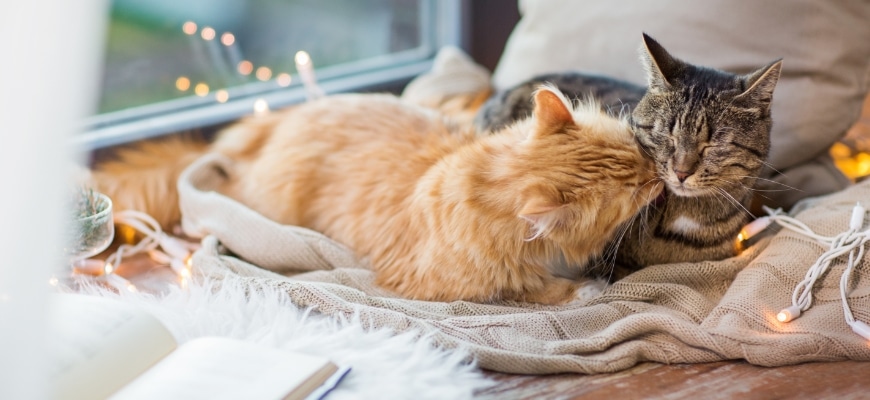
Cats play with each other by acting out instinctual hunting behaviors, such as chasing, pouncing, and wrestling, but they also spend time grooming and nuzzling each other.
How can you tell when your cats are playing or fighting? That can be challenging for cat owners. I know that when my cats play, it can look like an all-out war when really all is cool between them, and they are the best of friends.
When cats play, their body language is generally relaxed and non-threatening.
Playful cats might pounce, chase, bat at each other with their paws, and even playfully nip or wrestle. Their tails are often held upright, and their ears tend to be neutral.
You might also hear some playful chatter between your cats, such as chirping or soft meowing. Also, during play, cats often take turns being the “aggressor,” although there’s no intent to harm or injure the other cat.
In contrast, when cats fight, their body language becomes tense and aggressive.
In a scrap, the cats’ tails might puff up, and their ears will likely be held flat against their heads. The vocalizations change to growls, hisses, and the loud, aggressive yowls we’ve all heard outside late at night.
Cats in a fight often have their claws fully extended, and their bites are more forceful, with the intent to harm. The fur on their backs may stand on end, and their overall posture is more confrontational. Unlike play, where cats switch roles frequently, there is a clear aggressor and a victim in a real fight.
Chasing And Running
When cats play, they usually chase each other and run away, sometimes sprinting around in circles one behind the other until you can’t be sure who is chasing who!
Pouncing
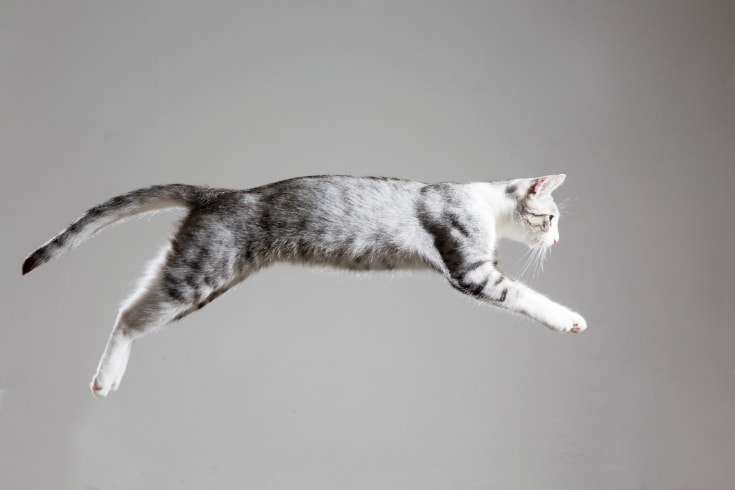
My cats love to pounce as part of their playtimes. One cat hides under my dining table and waits for the other to pass by, leaping out and pouncing on her.
Wrestling
Although it can look quite scary, cats often wrestle when playing together, but as long as the fur doesn’t start flying, this kind of play is typically harmless. The larger of my two cats usually dives up on top of his sister, pinning her down in a mock fight, although she never comes to any harm.
Stalking
Stalking is a typical cat hunting behavior that you’ll often see in outdoor cats when on the scent of a bird or rodent in your backyard. Cats stalk each other during play, too, doing a leopard crawl across the ground before pouncing on the other participant in the game.
Object Play
Object play is when the cat’s natural hunting instincts come into play! The cats chase a toy or moving light to see who can grab it first. Although you’ll need to instigate that part of the game, you’ll probably find that your cats will carry it on with toys like catnip mice and the like.
Role Reversal
When they’re playing, cats generally swap roles, with one becoming the aggressor and the other acting as the victim. However, keeping an eye on your cats is advisable to ensure one is not bullying the other.
Grooming And Nuzzling
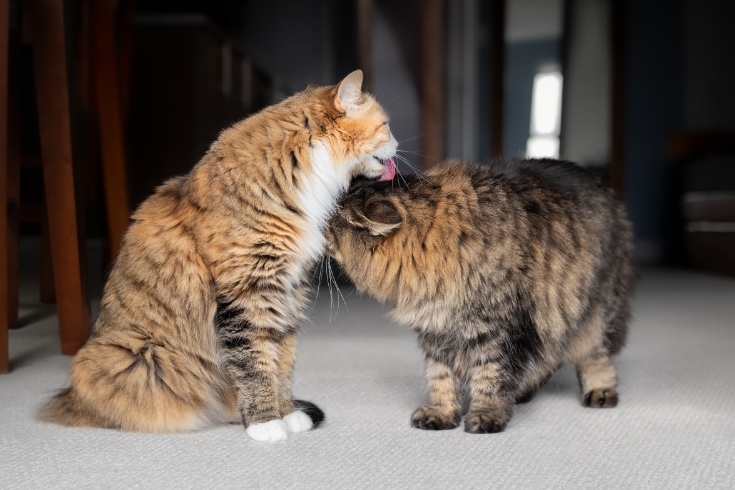
An important part of cat interactive play is when both parties groom and nuzzle each other in a friendly, sociable way. Cats have a social structure, and grooming is an essential part of that. When the cats groom each other, they form stronger social bonds rather like we do when engaging in shared activities and nuzzling up together is a way of showing trust and affection.
Chirping And Vocalizations
When your cat is watching the birds outside from a windowsill or stalking a moth that’s trapped in your house, she will often make chirping sounds. That vocalization simply means your cat is super excited about the game she’s playing with her housemate.
Chattering At Birds
Cats vocalize when they’re excited about something, so if your kitties are chattering and chirping at the birds outside your window, that’s usually because they’re anticipating the thrill of a hunt.
Play-Fighting And Mock Biting
Mock biting and play-fighting can look pretty scary to cat owners, but no injuries will be inflicted, and both cats should walk away from the “battle” unscathed.
My two cats often play-fight, rolling over and over, pretending to bite each other, meowing, squealing, and making a terrible row, but it’s all in fun. Play-fights are simply a dress rehearsal for the real thing, should they ever have to defend themselves in the real world.
Interactive Gaze
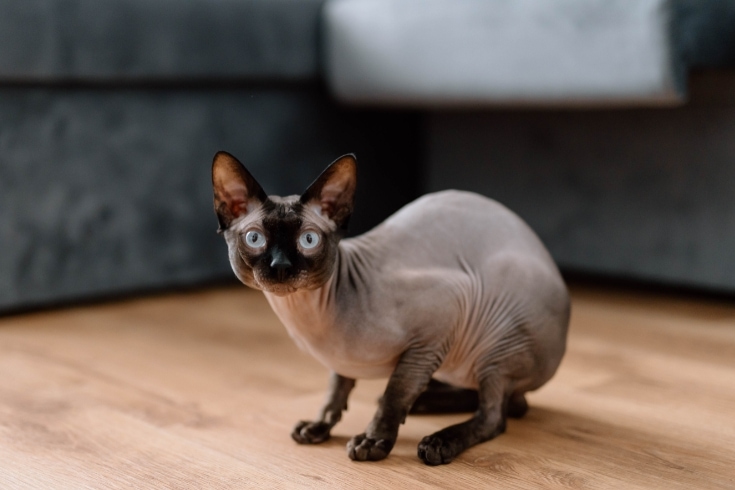
When cats play, they often lock eyes in what’s called an interactive gaze. An interactive gaze is a form of feline communication that conveys the cats’ intentions, such as an invitation to have a game, go on a hunting expedition, or perhaps have a play-fight.
Joint Exploration
Do you know how adventures are so much more fun when shared with your best chum? Well, cats seem to think the same, often heading off together to explore unfamiliar territory, perhaps to find new friends or to locate better hunting grounds.
What Are The Best Toys For Cats?
Best toys for cats come in many forms, depending on what kind of games your kitty enjoys the most.
The best kitten toys usually involve chasing, pouncing, and climbing, and the best toys for cats of all ages include scratching posts, kicker toys, and laser pens.
You can read a full overview of all the wonderful cat toys available in the article at this link. Meanwhile, here’s a quick taster of what toys you can get for your pampered princess pussycat!
Interactive Cat Toys
Interactive cat toys are the best choice for owners who like to get involved in playtime rather than letting their pets play solo.
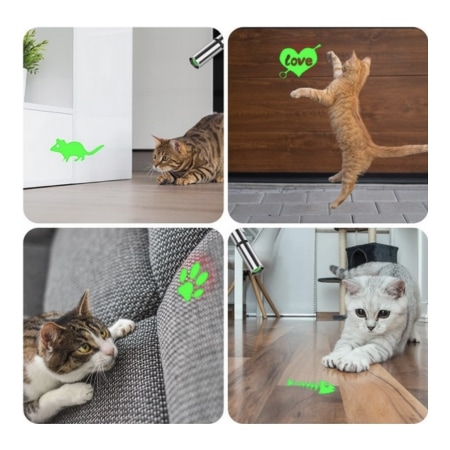
Toys like feather wands and laser pens fall under the category of interactive toys since they need an element of human interaction to work. These toys are brilliant for overweight cats who are reluctant to exercise and can help to build a stronger bond between you and your pet.
Chasing And Pouncing Toys
These toys are ideal for cats who are happy to play alone while you’re out, and cats love them since they allow kitty to indulge her hunting instincts and behaviors without harming any living creatures.
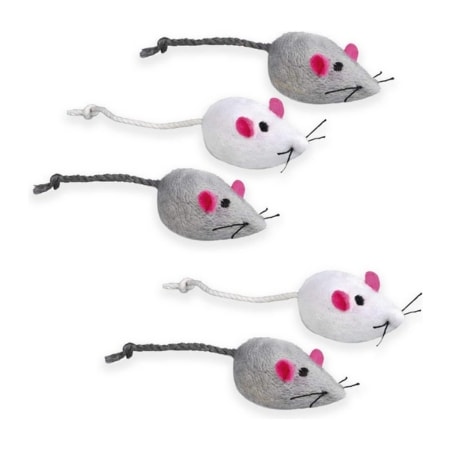
Popular chasing and pouncing toys include fluffy mice and catnip-scented critters.
Puzzle And Treat-Dispensing Toys
Puzzle and treat-dispensing toys can help prevent boredom and provide mental stimulation for cats left home alone while you’re out at work. Basically, the cat must figure out how to activate the toy to release a tasty treat reward.
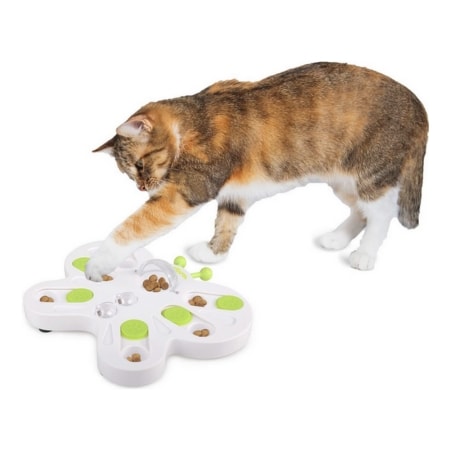
I love these toys for older cats that aren’t as agile and athletic as they once were.
Comfort Toys
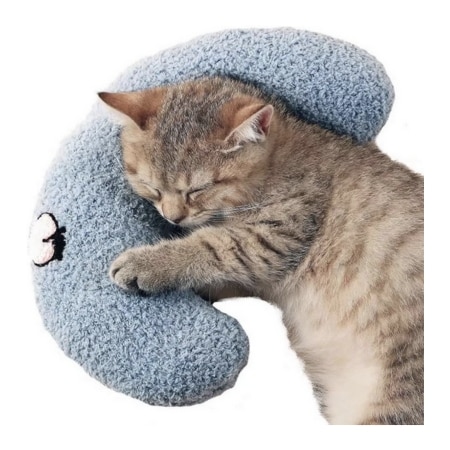
Comfort toys are great for insecure kittens and cats with anxiety issues or joint pain. These toys sometimes have a “heartbeat” that mimics that of a mother cat, and all are fluffy, soft, and perfect for snuggling into.
Cat Chew Toys
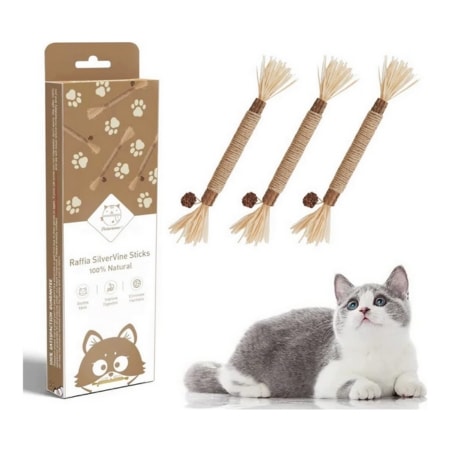
Some cats and teething kittens can be destructive around your home, chomping on wooden furniture like puppies and causing considerable damage. You can protect your stuff by providing your furry friend with a chew toy to gnaw on instead of your shagpile carpets!
Climbing Toys
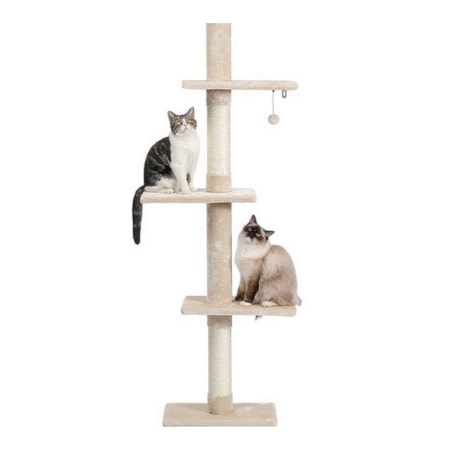
Cats of all ages are natural climbers, seeking the highest point and best view of approaching prey and predators. Keep your cat from climbing onto a shelf and endangering your ornaments by providing her with a climbing toy and perch, and remember to put the toy well away from surfaces your cat could leap onto.
Scratching Posts
A scratching post is essential if you want to keep your carpets and home furnishings free from damage. Cats scratch to keep their claws in good condition and to mark their territory using the scent pads in their paws. Scratching and stretching are also excellent forms of exercise, kind of like Pilates for cats!
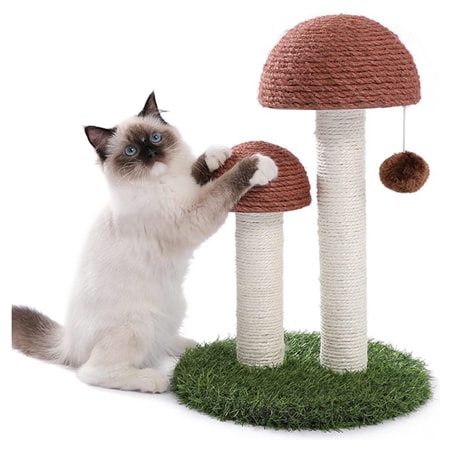
If you have a multi-cat household, having several scratching posts around your home is a good idea so that each cat can claim its own territory.
Household Items
Some household items can make handy cat toys, which is great news if you’re on a budget or you’re a keen recycler.
The following household items work well as kitty toys!
- Empty toilet rolls stuffed with scrunched-up paper make good pouncing toys
- Cotton reels are fun to bat and chase
- Empty cardboard boxes are great for hiding inside
Kicker Toys
Kicker toys are perfect for replicating your feline friend’s natural hunting behavior. When your cat grabs a prey critter, she wraps her legs around the victim, kicking and biting it, and she’ll do the same to a kicker toy!
Kicker toys provide your cat with a fantastic physical workout and keep her mentally satisfied, helping to keep stress and frustration at bay.
Can You Train A Cat By Playing?
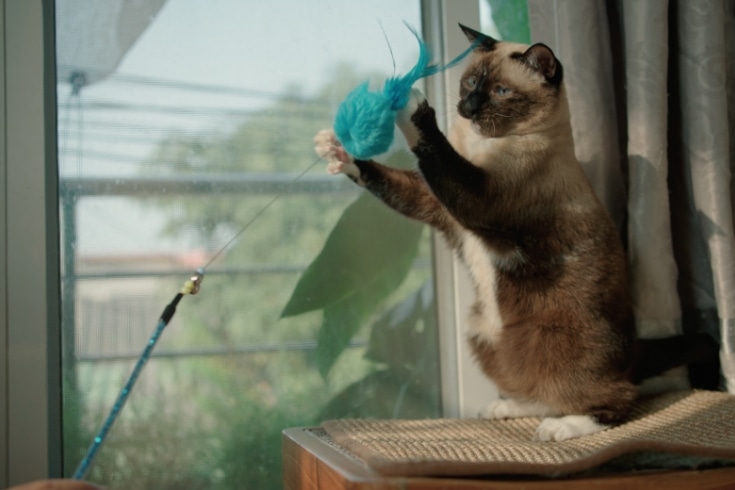
Yes, training a cat by playing is not only possible, but it’s one of the most effective methods for building a bond with your feline friend and teaching them new behaviors.
You can turn training into a game by teaching your cat to fetch a ball, jump through a hoop, complete a simple obstacle course, and follow a target toy.
What Are The Training Methods Where You Can Play With Your Cat?
Cats’ play can be incorporated into their training program, as described above.
Here’s a more detailed overview of the training methods you can use as part of your cat’s playtime.
Clicker Training
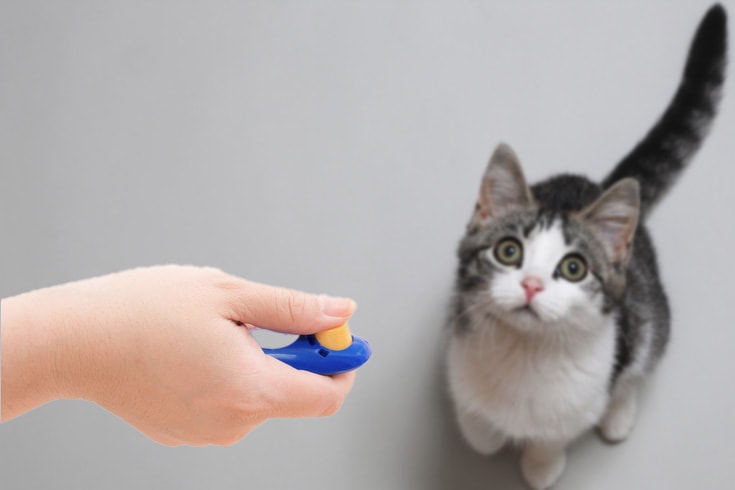
Clicker training involves using a small handheld device that clicks when squeezed. The idea is to click the clicker immediately after your cat has responded appropriately to a verbal cue or performed a trick, rewarding her simultaneously. That way, the cat learns to associate the click with an immediate reward, making her more likely to respond correctly to your verbal cues in the future.
You can use clicker training to teach your cat to negotiate an agility course, incorporating play with training.
Target Training
A target stick is a short wand with a ball or feather fixed to one end. The idea is to encourage your curious cat to focus on and follow the target. You can use a target stick to train your furry friend to jump over a small obstacle or move to a specific place, incorporating playtime into your training.
Retrieve And Fetch
Although it sounds like something you’d train your dog to do, cats can also learn to fetch and retrieve small, lightweight objects on command. Now, most cat owners have seen their cats bring them “gifts” such as dead mice and birds, so retrieving things is actually no big deal for your kitty. The trick is to have your cat fetch you a toy on command, turning training into playtime!
Jumping And Agility Training
Young cats are typically quite agile and love to jump and climb, making jumping and agility training a perfectly natural game to play. So, you can use that aspect of your training program as an opportunity to enjoy a fun game with your pet.
High-Five Or Shake Hands
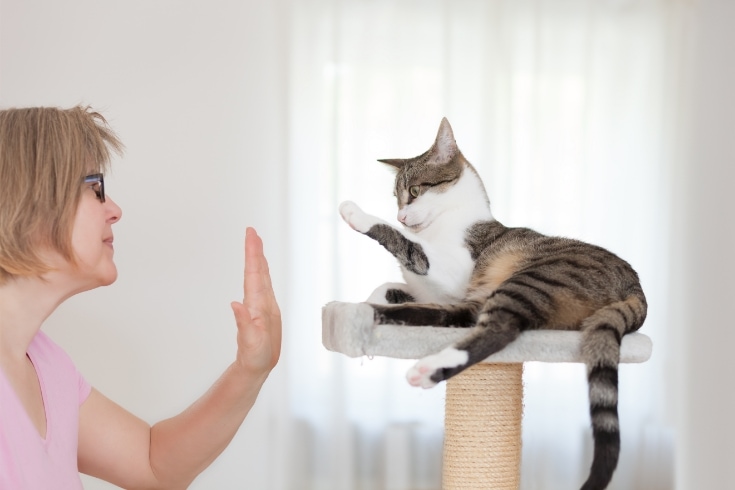
Cats naturally like to explore things with their paws, regularly standing up to paw at unfamiliar objects or catching insects trapped inside your home. So, training a cat to give you a high-five or shake your hand is really just an extension of a natural play behavior.
Hide And Seek With Toys
Playing hide and seek with toys is an extension of your cat’s hunting instincts. You can train your kitty to hunt around your home for her favorite catnip mouse, which can quickly turn into a fun game for her.
Interactive Puzzle Toys
Puzzle toys can provide valuable mental stimulation for house cats that don’t have access to outside space. You can easily convert a training exercise into a game by teaching your cat to figure out a puzzle toy.
Teach Tricks
Many cats can be taught simple tricks like jumping through hoops, retrieving a small toy, and coming when called. Use positive reinforcement and reward-based training techniques to make your cat’s lessons fun and turn school time into playtime!
Agility Courses
Watch your cat playing in your backyard, and you’ll see her jumping over obstacles, climbing trees, and exploring the deep undergrowth around her. You can incorporate all those natural behaviors into a fun training routine by building a simple agility course using household objects. The only difference is that your cat will play in response to your verbal training cues!
FAQs
In this part of our guide, we answer some of the most commonly asked questions about how to play with cats.
How Often Should I Play With My Cat For Optimal Health?
Playing with your cat provides her with mental and physical stimulation that’s essential for optimal health. Ideally, you should factor in at least one short playtime session daily. Cats have a relatively short attention span, and I’ve always found that 15 minutes of fun and games is usually long enough for most cats.
What Are Some DIY Cat Toys I Can Make At Home?
If you don’t want to splurge your budget on cat toys, you can make some pretty neat ones from unwanted stuff you likely have lying around your home.
For example, empty loo rolls stuffed with scrunched-up paper make perfect pouncing toys, and empty cotton reels can be fun to chase. Provided the materials you use are safe and won’t harm your cat, the only limit to what you can create is your imagination!
Why Is Play Important For Senior Cats?
Senior cats shouldn’t be allowed to become couch potatoes, especially if they spend most of their lives indoors. As cats age, they become more prone to health conditions like arthritis and heart problems, which are exacerbated if the cat is overweight or obese.
Play is an important form of exercise that keeps your cat’s mind and body active, helping to keep the aging process at bay and giving your cat the best quality of life as she enters her senior years.
Can I Overexert My Cat During Playtime?
Yes, it is possible to overexert your cat during playtime, especially if she’s getting on in years or has mobility issues.
When playing with your cat, pick a time of day when she’s well-rested, isn’t hungry, and isn’t expecting to go out. Keep playtime and training sessions short and sweet, and always quit if your cat loses interest or appears distressed.
Of course, If you are at all concerned about your cat’s health, make an appointment for her to be checked over by your vet in case your pet has any underlying health conditions you’re not aware of.
What Role Does Playtime Play In Curbing Destructive Behavior?
Cats can become destructive when they don’t get enough physical exercise or mental stimulation. In other words, a bored cat will probably go looking for mischief unless you give her an alternative!
You can keep your cat entertained by offering her interactive toys to play with, including feather ones, kickers, and laser pointers, and climbing and scratching behaviors can be satisfied with scratching posts and perches. Those toys can help protect your furniture from claws, ornaments from a mountaineering cat, and shoes and pullovers from a cat that loves to wrestle and kick prey items.
How Can I Encourage Shy Cats To Engage In Play?
If you have a shy cat, you can try introducing toys focused on a distant object, like a feather wand, laser pointer, or catnip-filled mice and other catnip toys. Once you find the toys your cat likes, make sure to set aside a few minutes each day for play and other fun activities, and always use positive reinforcement and reward-based training methods.
Are There Any Playtime Activities That Can Help Reduce My Cat’s Stress?
Like humans, cats often benefit from staying active to reduce stress levels. Ensuring your cat has access to plenty of different toys to play with daily can help her stay engaged and prevent chronic boredom that can lead to stress.
You can also encourage your cat to use their cognitive abilities and keep her mentally alert by using puzzle feeders, scattering dry food in a snuffle mat, or hiding treats in used toilet paper rolls, which can make your pet work a bit harder to find her food.
What Are Some Signs That My Cat Is Enjoying Our Play Session?
There are several signs that your cat is enjoying playtime with you.
If your cat is purring while you’re playing together, that’s a good sign that she’s happy and relaxed. Your cat’s tail can tell you a lot about her mood, and if it twitches or wags playfully, it’s a sign that she’s enjoying herself.
Cats will often perk their ears forward when they’re excited or interested in something, so if your cat’s ears are up and alert during playtime, it’s a sure sign she’s having fun. If your cat joins in with the toy or game you’re playing, such as chasing after a toy mouse or batting at a feather wand, that’s a safe bet she’s enjoying herself.
Remember to always monitor your cat’s behavior during playtimes and respect her boundaries. If your cat becomes overstimulated, aggressive, or tired, stop the play session and give her space to recover and relax.
What Precautions Should I Take When Introducing New Toys For Playtime?
When introducing new toys for your cat’s playtime, taking a few precautions is important to ensure your pet’s safety and enjoyment.
Always supervise your cat during playtime, especially with new toys. That way, you can observe your pet’s behavior and be sure she’s not getting into anything dangerous. The toy must be an appropriate size for your cat. Avoid toys that are too small and can be easily swallowed or toys that are too big and could cause injury.
Choose toys made from safe, non-toxic materials, and avoid those with small parts or loose strings that your cat might swallow or choke on.
By taking these precautions, you can make every playtime safe and fun for your furry friend!
Conclusion
You can help reduce your cat’s stress levels, provide mental stimulation and physical activity, and keep her from becoming bored and destructive by providing access to a variety of different toys.
Many toys encourage your cat to indulge in her natural hunting behaviors, which is important for your pet’s mental health. In addition, interactive playtime is great for pet-owner bonding. Be careful when introducing new toys for playtime, supervising your cat, choosing appropriate-sized toys made from safe, non-toxic materials, and avoiding toys with small parts or loose strings that your cat might swallow or choke on.
Taking time out to play with your cat is crucial in maintaining a healthy, fulfilling life for your pet and building a healthy bond between you.